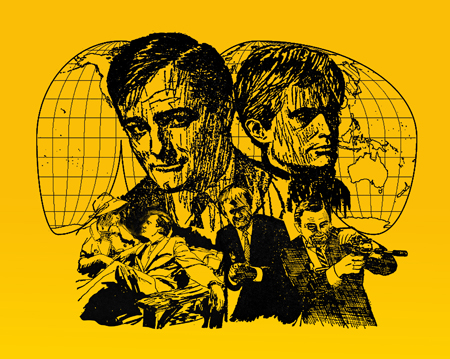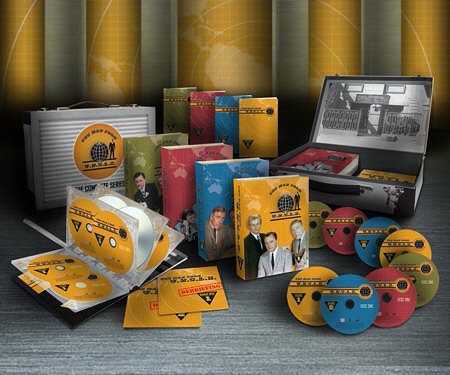
In commemoration of the 50th anniversary of The Man From U.N.C.L.E. and in anticipation of the forthcoming big screen version of the classic television series, Cinema Retro will be offering periodic reviews of individual episodes of the show, which aired between September 1964 and January 1968. The episodes will be chosen at random and not presented in any specific order, thus offering analysis of telecasts from the four seasons. Reviews will be written by U.N.C.L.E. scholars and long-time devotees of the series.
BY C.W. WALKER
Air
Date: February 1, 1965; repeated June 21, 1965
Filmed
December 16-18; 21-23, 1964
Director:
Seymour Robbie
Writer:
Dick Nelson
Whenever
fans new to The Man from U.N.C.L.E.
ask me which episodes they should start with, The Mad Mad Tea Party Affair is always at the top of my list. It was filmed
just before Christmas and aired in February, midway through the first season
when the series was really hitting its stride. Although it lacks the film noir
feel of some other first season episodes like “The Dove Affair†and “The Never
Never Affair†or the colorful ‘60s vibe of later seasons, it contains all the
elements that defined the series and made it so enormously popular. In many
ways, this is a quintessential episode.
The
plot effectively employs a three-cornered structure so integral to the series
which always includes an initially confused but ultimately helpful Innocent; a smart,
powerful and deadly Villain, and of course, the agents supported by the
U.N.C.L.E. organization. In this case, the Innocent is a hapless store clerk
named Kay Lorrison played by Zohra Lampert, who many will remember from the
Goya Bean commercials of the 1980s. Lorrison is with her fiancée, Walter, buying
lunch from a pushcart on a New York side street, when a mysterious man
accidentally-on-purpose smears mustard on her dress, necessitating a trip into
Del Floria’s dry cleaning shop to take care of the damage.
One
of the attractions of The Man from U.N.C.L.E.
series was its central “wainscot fantasy†--- that is, the idea that an
incredible but largely invisible and exotic world of spies fighting evil existed
side by side with our everyday, mundane existence. As with Harry Potter’s
Hogwarts, young folks in the audience wanted to believe that U.N.C.L.E. was real
(the official sounding disclaimer at the end of each episode told us so!) and adults
could have fun playing along. Everyone coveted an U.N.C.L.E. identification
card (preferably gold) or fervently hoped that one day, Napoleon Solo and Illya
Kuryakin would come knocking on our door, dragging us along with them to save
the world. Even the United Nations got into the act when visitors asked guides
to allow them a peek at U.N.C.L.E.
headquarters.
The
bad guys (often, but not always) were in league with Thrush, and could be found
lurking just behind the facades of the most innocuous places like book stores
and car washes, beauty salons and vacuum cleaner repair shops. To enter
U.N.C.L.E.’s sleek futuristic headquarters (what Kay later describes as this
“chrome and gunmetal madhouseâ€), all you had to do was pull the coat hook in
the middle booth of Del Floria’s. Poor Kay: she doesn’t even pull that iconic
hook. While she’s still patiently waiting, dressed in just her underwear, the
back wall suddenly swings open, revealing U.N.C.L.E.’s pulsing high tech reception area and, like
Alice, Kay is suddenly propelled through a modern looking glass.
The
episode acknowledges its debt to Lewis Carroll with act titles like “The Rabbit
Hole Revisited†and “The Mad Hatter’s Inquisition.†Dick Nelson only wrote two
other episodes besides this one, but with his contributions of the retired
agent, Albert Sully in “The Odd Man Affair,†and the infamous Thrush operative,
Angelique, in “The Deadly Games Affair,†his contribution to the series’ canon
was considerable.
Kay’s
unplanned sojourn at HQ means she may miss her own wedding, but there’s a much
larger crisis shaping up in the form of increasingly serious threats being made
against U.N.C.L.E. which is hosting a top secret international summit within
the HQ building later that day. The aforementioned mysterious man (a bemused
Richard Haydn), who begins the story by attacking HQ with a model airplane,
turns out to be a red herring: he’s actually U.N.C.L.E. chief Alexander Waverly’s
brother-in-law, a logic professor named Hemingway. The real villain is Riley (a
misleadingly pleasant Peter Haskell) a mole in U.N.C.L.E.’s demolition lab, who
is working under the direction of the notorious Thrush scientist, Dr. Egret.
Egret
is notable, not only because she is a formidable professional woman, but also
because she could effectively transform her physical appearance. Thus
disguised, she was supposed to be a recurrent antagonist but played by
different actresses. As it turned out, she will show up only once more, in “The
Girls from Nazarone Affair,†definitely a lost opportunity.
Along
with the Innocent, the Villain and the agents all scrambling around the sleek,
shiny corridors of U.N.C.L.E. headquarters, , “The Mad Mad Tea Party†also features some interesting gadgetry, including
an innocent looking pen that, when pressed against a skull, can instantly homogenize
a brain. This wicked weapon is deliberately contrasted with Hemingway’s more mundane attempts to keep the
agents on their toes. For the most part, veteran television director Seymour
Robbie plays it straight and simple, although he does include a particularly
notable low angle shot of shell casings sliding across the corridor floor after
a shootout.
It
all ends well of course, but not before some very close calls, enough for Kay
to realize that although the life of an enforcement agent can be terribly
exciting, she’s better off pursuing a nice quiet life with good old boring
Walter. I’m not quite sure we in the audience felt the same way. Illya looks
awfully dashing in that black turtleneck at the end, and his playful wink is
certainly inviting.

CLICK HERE TO ORDER THE ENTIRE SERIES, WITH HOURS OF BONUS EXTRAS, FROM AMAZON AND SAVE $116!